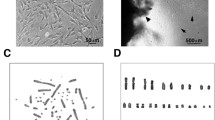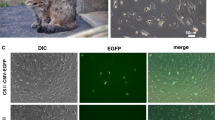Abstract
Primary cell cultures from crustacea have been initiated since the 1960s, yet no permanent cell line is available. Primary cells have a limited proliferative capacity in culture due to cellular senescence, which is regulated by a group of dominant senescence genes. The aim of this research was to manipulate cell cycle regulation by transfecting Cherax quadricarinatus primary cells with oncogenes, in an effort to induce a permanent cell line. Human papillomaviruses (HPV) play a critical role in the formation of anogenital cancer. Research has demonstrated that the HPV-expressed E6 and E7 proteins function concomitantly to disrupt the p53 and retinoblastoma (Rb) tumor suppressor genes, regulators of the cell-cycle checkpoints at the first gap (G1) phase. HPV E6 and E7 genes were transfected into the C. quadricarinatus cells by lipofection. Successful transfection was demonstrated by the presence of oncogene messenger RNA by reverse transciptase polymerase chain reaction. At day 150, transfected cells still remain viable, although cell proliferation was stagnant. It may be that while transfection of the oncogenes was successful, no proliferation of the C. quadricarinatus cells was evident due to a lack of telomere maintenance.




Similar content being viewed by others
References
Bodnar, A. G.; Ouellette, M.; Frolkis, M.; Holt, S. E.; Chiu, C. -P.; Morin, G. B.; Harley, C. B.; Shay, J. W.; Lichtsteiner, S.; Wright, W. E. Extension of life-span by introduction of telomerase into normal human cells. Science 2795349: 349–352; 1998. doi:10.1126/science.279.5349.349.
Boyer, S. N.; Wazer, D. E.; Band, V. E7 protein of human papilloma virus-16 induces degradation of retinoblastoma protein through the ubiquitin–proteasome pathway. Cancer Res. 5620: 4620–4624; 1996.
Brodsky, J. L.; Pipas, J. M. Polyomavirus T antigens: molecular chaperones for multiprotein complexes. J. Virol. 727: 5329–5334; 1998.
Chen, W. -H.; Lai, W. -F.; Deng, W. -P.; Yang, W. K.; Lo, W. -C.; Wu, C. -C.; Yang, D. -M.; Lai, M. -T.; Lin, C. -T.; Lin, T. -W.; Yang, C. -B. Tissue engineered cartilage using human articular chondrocytes immortalized by HPV-16 E6 and E7 genes. J. Biomed. Res. 76A3: 512–520; 2006. doi:10.1002/jbm.a.30560.
Colgin, L. M.; Reddel, R. R. Telomere maintenance mechanisms and cellular immortalization. Curr. Opin. Genet. Dev. 91: 97–103; 1999. doi:10.1016/S0959-437X(99)80014-8.
Crane, M. J. Mutagenesis and cell transformation in cell culture. Method Cell. Sci. 214: 245–253; 1999. doi:10.1023/A:1009861505170.
Crane, M. J., Williams, L. M. Development of continuous prawn cell lines for virus isolation and cultivation. Fisheries Research & Development Corporation. Ed. Geelong, CSIRO Livestock Industries; 2002.
Defilippis, R. A.; Goodwin, E. C.; Wu, L.; Dimaio, D. Endogenous human papillomavirus E6 and E7 proteins differentially regulate proliferation, senescence and apoptosis in HeLa cervical carcinoma cells. J. Virol. 772: 1551–1563; 2003. doi:10.1128/JVI.77.2.1551-1563.2003.
Edgerton, B.; Owens, L. Age at first infection of Cherax quadricarinatus by Cherax quadricarinatus bacilliform virus and Cherax giardiavirus-like virus, and production of putative virus-free crayfish. Aquaculture 1521–4: 1–12; 1997. doi:10.1016/S0044-8486(97)00006-9.
FAO The state of world aquaculture. FAO Fish. Tech. Pap. 500: 1–134; 2006.
Freshney, R. I. Culture of animal cells: A manual of basic techniques. Wiley-Liss, New York2000.
Goodwin, E. C.; Yang, E.; Lee, C. J.; Lee, H. W.; Dimaio, D.; Hwang, E. S. Rapid induction of senescence in human cervical carcinoma cells. Proc. Natl. Acad. Sci. U. S. A. 9720: 10978–10983; 2000. doi:10.1073/pnas.97.20.10978.
Ha, P. K.; Califano, J. A. The role of human papillomavirus in oral carcinogenesis. Crit. Rev. Oral Biol. M. 154: 188–196; 2004.
Halbert, C. L.; Demers, G. W.; Galloway, D. A. The E7 gene of human papillomavirus type 16 is sufficient for immortalization of human epithelial cells. J. Virol. 651: 473–478; 1991.
Harms, W.; Rothamel, T.; Miller, K.; Harste, G.; Grassmann, M.; Heim, A. Characterization of human myocardial fibroblasts immortalized by HPV16 E6–E7 genes. Exp. Cell Res. 2682: 252–261; 2001. doi:10.1006/excr.2001.5274.
Hollstein, M.; Sidransky, D.; Vogelstein, B.; Harris, C. C. p53 mutations in human cancers. Science 2535015: 49–53; 1991. doi:10.1126/science.1905840.
Huschtscha, L. I.; Holliday, R. Limited and unlimited growth of SV40-transformed cells from human diploid MRC-5 fibroblasts. J. Cell. Sci. 631: 77–99; 1983.
Kingsley, K.; Johnson, D.; O’malley, S. Transfection of oral squamous cell carcinoma with human papillomavirus-16 induces proliferative and morphological changes in vitro. Cancer Cell. Int. 61: 14–25; 2006. doi:10.1186/1475-2867-6-14.
Ko, L. J.; Prives, C. p53: puzzle and paradigm. Genes Dev. 109: 1054–1072; 1996. doi:10.1101/gad.10.9.1054.
Lang, G. -H.; Wang, Y.; Nomura, N.; Matsumara, M. Detection of telomerase activity in tissues and primary cultured lymphoid cells of Penaeus japonicus. Mar. Biotechnol. 64: 347–354; 2004. doi:10.1007/s10126-003-0038-0.
Levine, A. J. p53, the cellular gatekeeper for growth and division. Cell 883: 323–331; 1997. doi:10.1016/S0092-8674(00)81871-1.
Macdonald, C. Development of new cell lines for animal cell biotechnology. Crit. Rev. Biotechnol. 102: 155–178; 1990. doi:10.3109/07388559009068265.
O’Brien, V. Viruses and apoptosis. J. Gen. Virol. 798: 1833–1845; 1998.
Perez-Reyes, N.; Halbert, C. L.; Smith, P. P.; Benditt, E. P.; Mcdougall, J. K. Immortalisation of primary human smooth muscle cells. Proc. Natl. Acad. Sci. U. S. A. 894: 1224–1228; 1992. doi:10.1073/pnas.89.4.1224.
Putral, L. N.; Bywater, M. J.; Gu, W.; Saunders, N. A.; Gabrielli, B. G.; Leggatt, G. R.; Mcmillan, N. A. J. RNA interference against human papillomavirus oncogenes in cervical cancer cells results in increased sensitivity to cisplatin. Mol. Pharmacol. 685: 1311–1319; 2005. doi:10.1124/mol.105.014191.
Ratner, L.; Josephs, S. F.; Wong-Staal, F. Oncogenes: their role in neoplastic transformation. Annu. Rev. Microbiol. 391: 419–449; 1985. doi:10.1146/annurev.mi.39.100185.002223.
Sager, R. Tumor suppressor genes in the cell cycle. Curr. Opin. Cell Biol. 42: 155–160; 1992. doi:10.1016/0955-0674(92)90026-9.
Sasaki, M.; Honda, T.; Yamada, H.; Wake, N.; Barrett, J. C. Evidence for multiple pathways to cellular senescence. Cancer Res. 5423: 6090–6093; 1994.
Scheffner, M.; Werness, B. A.; Huibregtse, J. M.; Levine, A. J.; Howley, P. M. The E6 oncoprotein encoded by human papillomavirus types 16 and 18 promotes the degradation of p53. Cell 636: 1129–1136; 1990. doi:10.1016/0092-8674(90)90409-8.
Shay, J. W.; Wright, W. E.; Brasiskyte, D.; Van Der Haegen, B. A. E6 of human papillomavirus type 16 can overcome the M1 stage of immortalisation in human mammary epithelial cells but not in human fibroblasts. Oncogene 86: 1407–1413; 1993.
Shiga, T.; Sharasawa, H.; Shimizu, K.; Dezawa, M.; Masuda, Y.; Simizu, B. Normal human fibroblasts immortalised by introduction of human papillomavirus type 16 (HPV-16) E6–E7 genes. Microbiol. Immunol. 414: 313–319; 1997.
Spann, K. M.; Lester, R. J. G. Viral diseases of penaeid shrimp with particular reference to four viruses recently found in shrimp from Queensland. World J. Microb. Biotechnol. 131: 419–426; 1997. doi:10.1023/A:1018576200670.
Strachan, T.; Read, A. P. Human molecular genetics, 2nd ed. Wiley, New York; 1999.
Tapay, L. M.; Lu, Y.; Brock, J. A.; Nadala, E. C.; Loh, P. C. Transformation of primary culture of shrimp (Penaeus stylirostris) lymphoid (Oka) organ with Simian virus-40 (T) antigen. Proc. Soc. Exp. Biol. Med. 2091: 73–78; 1995.
Teodoro, J. G.; Branton, P. E. Regulation of apoptosis by viral gene products. J. Virol. 713: 1739–1746; 1997.
Villena, A. J. Applications and needs of fish and shellfish cell culture for disease control in aquaculture. Rev. Fish Biol. Fish 131: 111–140; 2003. doi:10.1023/A:1026304212673.
Wazer, D. E.; Liu, X. -L.; Chu, Q.; Gao, Q.; Band, V. Immortalization of distinct human mammary epithelial cell types by human papilloma virus 16 E6 or E7. Proc. Natl. Acad. Sci. U. S. A. 929: 3687–3691; 1995. doi:10.1073/pnas.92.9.3687.
Werness, B. A.; Levine, A. J.; Howley, P. M. Association of human papillomavirus types 16 and 18 E6 proteins with p53. Science 2484951: 76–79; 1990. doi:10.1126/science.2157286.
Yamamoto, A.; Kumakura, S.; Uchida, M.; Barrett, J. C.; Tsutsui, T. Immortalization of normal human embryonic fibroblasts by introduction of either the human papillomavirus type 16 E6 or E7 gene alone. Int. J. Cancer 1063: 301–309; 2003. doi:10.1002/ijc.11219.
Acknowledgment
We thank Dr. Germain Fernando (CICR Princess Alexandra Hospital, Brisbane, Australia) for kindly providing the vectors containing the human papillomavirus-16 oncogenes E6 and E7.
Author information
Authors and Affiliations
Corresponding author
Additional information
Editor: J. Denry Sato
Rights and permissions
About this article
Cite this article
Claydon, K., Owens, L. Attempts at immortalization of crustacean primary cell cultures using human cancer genes. In Vitro Cell.Dev.Biol.-Animal 44, 451–457 (2008). https://doi.org/10.1007/s11626-008-9141-x
Received:
Accepted:
Published:
Issue Date:
DOI: https://doi.org/10.1007/s11626-008-9141-x




